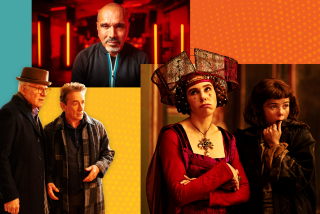Review: Gripping ‘The Missing’ advances with Hitchcock-like tautness
“The Missing,” which begins Saturday on Starz, is a new miniseries about the disappearance of a child — the aftermath of the disappearance of a child, to be precise. It is eight hours long, and I watched it all in a single sitting.
Imperiled children have been central to other dark, quality cable series of late, including “The Killing,” “Top of the Lake” and “Broadchurch.” It does give a story a certain weight and heat. After having lived through so many murder mysteries, police procedurals and slasher films, what’s one more grown-up murdered or missing? We carry on. A child victim shocks us back to attention, shifts the ground under our feet, etches loss with acid.
Cutting back and forth between the summer of 2006 and the winter of 2014, “The Missing” is at once an unfolding mystery and a cold-case story. James Nesbitt and Frances O’Connor play Tony and Emily Hughes, a London couple vacationing in France with their 5-year-old son, Oliver. Their car breaks down in the middle of nowhere (a familiar horror movie trope), and they are forced to put up in a country town whose populace has been temporarily deranged by the 2006 World Cup as the French team battles toward the finals.
The opening scenes — in which the facts of the case are slowly established in the present tense, while in the past the family proceeds toward a loss you know is coming — have the suspense and swing of good Alfred Hitchcock; indeed, Hitchcock made his own lost-child movie, “The Man Who Knew Too Much,” and liked it enough to make it again, and there is some tonal resemblance between Nesbitt here and the driven James Stewart in the 1956 version of the Hitchcock film.
The title can be taken to include Tony, who disappears from his own life, consumed by what he doesn’t know. But while it’s his mania and temper that drive the story forward, screenwriters Harry and Jack Williams and sole series director Tom Shankland have made what is very much an ensemble piece, one in which even minor characters come to vivid life and matter. And their story expands in unexpected ways; the show we think we’re watching, because we have seen other shows involving similar situations and characters, is always becoming something else. (For many of them it is, among other things, a kind of love story.)
Nesbitt, whom American audiences will perhaps best know from “Jekyll” and the “Hobbit” movies, is excellent, but O’Connor (recently seen as Mrs. Selfridge in the PBS series “Mr. Selfridge”) is perhaps even more remarkable as a woman who has tried to move on from the unthinkable to the livable; where Tony wears his wounds all on the outside, present-day Emily is outwardly composed — re-composed one might say — but still fractured within, in ways O’Connor somehow lets you see without ever exactly showing you. And as Julien Baptiste, the retired detective Tony draws back into the case, Tchéky Karyo brings an appealing, worn-in solidity and quiet humor that glues the story’s wilder elements together. He’s got his own challenges, though.
The tension between the timelines works well, allowing for parallel and contrasting action, raising and eventually answering questions as to how we got from then to now — where and when, for instance, did Baptiste acquire the limp that latterly afflicts him, and what is Ziane (Saïd Taghmaoui), a police officer in 2006, doing in jail in 2014?
It also lends the story an element of fatedness that “The Missing” beats back against: One of its themes is that there is room for decision even in a world fundamentally beyond your control. I make my own decisions and live with the consequences, Baptiste tells Tony, who often acts without deciding to.
The photography, by Ole Bratt Birkeland, is fluid when it needs to be and settled when it needs to be, and soaks in color and detail: the patterns on a wall, the lines on a face, the grass in a field, the snowflakes falling in a town square. At times it can seem a hair too careful or composed — if only because we are in a time of careful, composed cinematography in TV series — but for the most part it brings you into and the story, enriching the action without calling attention to itself. It is not merely sexy.
My quibbles are not major. We can talk about the ending once you’ve seen it, if you like. But I encourage you to see it, and all that goes before.
Twitter: @LATimesTVLloyd
More to Read
From the Oscars to the Emmys.
Get the Envelope newsletter for exclusive awards season coverage, behind-the-scenes stories from the Envelope podcast and columnist Glenn Whipp’s must-read analysis.
You may occasionally receive promotional content from the Los Angeles Times.







